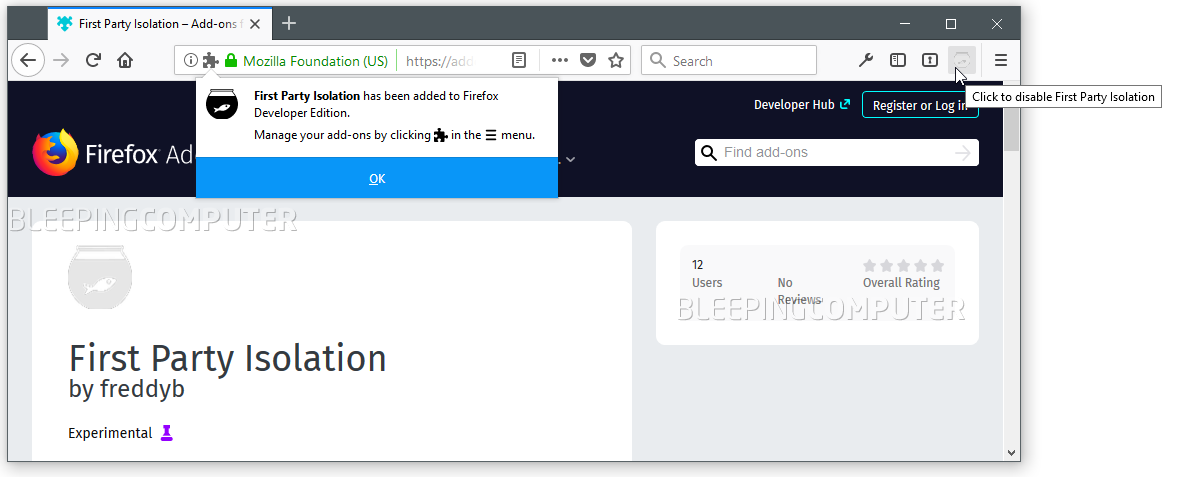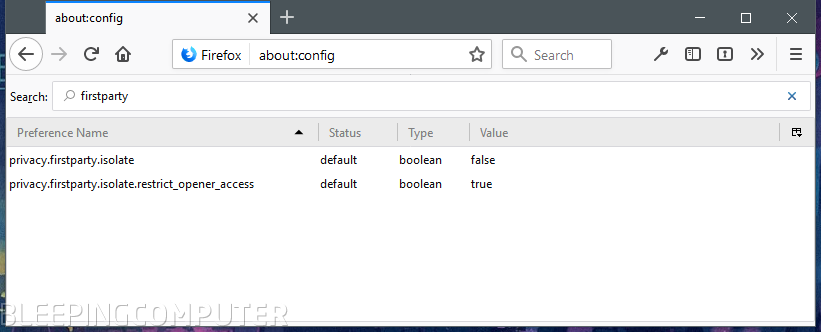- Oct 9, 2016
- 6,026
Unbeknown to most users, Mozilla added a privacy-enhancing feature to the Firefox browser over the summer that can help users block online advertisers from tracking them across the Internet.
The feature is named First-Party Isolation (FPI) and was silently added to the Firefox browser in August, with the release of Firefox 55.
What is First-Party Isolation
FPI works by separating cookies on a per-domain basis. This is important because most online advertisers drop a cookie on the user's computer for each site the user visits and the advertisers loads an ad.
With FPI enabled, the ad tracker won't be able to see all the cookies it dropped on that user's PC, but only the cookie created for the domain the user is currently viewing.
This will force the ad tracker to create a new user profile for each site the user visits and the advertiser won't be able to aggregate these cookies and the user's browsing history into one big fat profile.
Feature borrowed from the Tor Browser
This feature was first implemented in the Tor Browser, a privacy-focused fork of the Firefox browser managed by the Tor Project, where it is known as Cross-Origin Identifier Unlinkability.
FPI was added to Firefox as part of the Tor Uplift project, an initiative to bolster the Firefox codebase with some of the Tor Browser's unique privacy-focused features.
This is the third feature that has made it into the Firefox via the Tor Uplift project. Previously, Mozilla has added a mechanism to Firefox 52 that prevents websites from fingerprinting users via system fonts, and Firefox will also soon block websites from fingerprinting users via HTML5 canvas elements. This latter feature is scheduled for Firefox 58, to be released in mid-January 2018.
How to enable FPI
FPI support was added in Firefox 55, but very few users know about it because it was not included in the official release notes. Users had to dig long and hard to know that FPI even existed.
The feature is not enabled by default, as it's known to cause some login persistence problems. To enable it users have two options.
The first is to use a dedicated Firefox add-on. The add-on's name is "First Party Isolation," and once you install it, it immediately turns on FPI and adds a fishbowl icon on the Firefox UI.
Users can press this button to temporarily disable FPI (for five minutes). If users want to disable FPI for good, they can either disable or remove the add-on.

The second method of enabling FPI is by modifying parameters in the about:config settings page. To access this page, users must type about:config in the address bar and press Enter.
Once they reached the about:config page, they can search for "firstparty," and the two FPI parameters will appear.
To enable FPI, users must set "privacy.firstparty.isolate" to true by double-clicking it. The second parameter — "privacy.firstparty.isolate.restrict_opener_access" — works by lowering some of the "isolation" rules. Users can set this parameter to false if they're having problems logging into websites.

Another Tor Browser Feature Makes It Into Firefox: First-Party Isolation
The feature is named First-Party Isolation (FPI) and was silently added to the Firefox browser in August, with the release of Firefox 55.
What is First-Party Isolation
FPI works by separating cookies on a per-domain basis. This is important because most online advertisers drop a cookie on the user's computer for each site the user visits and the advertisers loads an ad.
With FPI enabled, the ad tracker won't be able to see all the cookies it dropped on that user's PC, but only the cookie created for the domain the user is currently viewing.
This will force the ad tracker to create a new user profile for each site the user visits and the advertiser won't be able to aggregate these cookies and the user's browsing history into one big fat profile.
Feature borrowed from the Tor Browser
This feature was first implemented in the Tor Browser, a privacy-focused fork of the Firefox browser managed by the Tor Project, where it is known as Cross-Origin Identifier Unlinkability.
FPI was added to Firefox as part of the Tor Uplift project, an initiative to bolster the Firefox codebase with some of the Tor Browser's unique privacy-focused features.
This is the third feature that has made it into the Firefox via the Tor Uplift project. Previously, Mozilla has added a mechanism to Firefox 52 that prevents websites from fingerprinting users via system fonts, and Firefox will also soon block websites from fingerprinting users via HTML5 canvas elements. This latter feature is scheduled for Firefox 58, to be released in mid-January 2018.
How to enable FPI
FPI support was added in Firefox 55, but very few users know about it because it was not included in the official release notes. Users had to dig long and hard to know that FPI even existed.
The feature is not enabled by default, as it's known to cause some login persistence problems. To enable it users have two options.
The first is to use a dedicated Firefox add-on. The add-on's name is "First Party Isolation," and once you install it, it immediately turns on FPI and adds a fishbowl icon on the Firefox UI.
Users can press this button to temporarily disable FPI (for five minutes). If users want to disable FPI for good, they can either disable or remove the add-on.

The second method of enabling FPI is by modifying parameters in the about:config settings page. To access this page, users must type about:config in the address bar and press Enter.
Once they reached the about:config page, they can search for "firstparty," and the two FPI parameters will appear.
To enable FPI, users must set "privacy.firstparty.isolate" to true by double-clicking it. The second parameter — "privacy.firstparty.isolate.restrict_opener_access" — works by lowering some of the "isolation" rules. Users can set this parameter to false if they're having problems logging into websites.

Another Tor Browser Feature Makes It Into Firefox: First-Party Isolation
